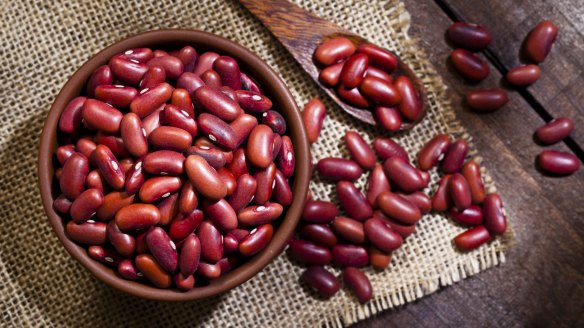Are raw kidney beans dangerous?

I have heard that beans, in particular kidney beans, can be toxic. GC
You think that plants are passive living things, producing nothing but leaves, flowers, fruit and pods, readily giving up their bounty to the fittest? Wrong. They are aggressive creatures producing all sorts of toxic brews to ward off attack. Some plants use amino acids to create alkaloids – bitter-tasting chemicals in their fruit. Others make terpenes to ward off insect attack and to stop other plants growing nearby. Beans produce a toxin called phytohaemagglutinin that affects cell metabolism in animals such as pigs, rats and humans. It is found in cannellini beans, mature broad beans and in dangerous amounts in red kidney beans. As few as five raw kidney beans can have health effects. Phytohaemagglutinin is rendered safe after cooking beans for 30 minutes at temperatures at or above 100C. Canned red kidney beans that have been cooked at this temperature for this time are safe and nutritious. Slow-cooking dried red kidney beans will not deactivate the toxin as temperatures in a slow-cooker often do not reach above 80C.
I have a meat cookbook and there are several recipes for koftas. One is for Lebanese kaftas and another for Indian koftas. Are they same thing? L. Haig
I just had a fleeting thought that there may have been a book published called The United Nations of Mince. Which funnily enough helps explain why there is a family of minced meat dishes from the western Mediterranean region of Africa across the Middle East to the Indian subcontinent. What unites them is the word kofta, from the Persian verb koftan, which means "to grind". In Morocco they serve kufta, the Greeks have their keftedes, in former Yugoslavian nations you'll eat cufte, while in Lebanon they can make kafta with beef. In India you'll find the Nargisi kofta, spiced lamb mince surrounding a semi-hard boiled egg, a concept appropriated by the British Raj. It returned to Britain as a cold dish without the spicy sauce. We know them today as scotch eggs.
Why does bottled orange juice have added flavour? P. Krauth
Sometimes processed foods undergo so much change to render them shelf-stable that they no longer bear any resemblance to the original dish. Freshly squeezed orange is a simple pleasure and at this time of the year, when local citrus is abundant, it's readily available and affordable. With the right balance of acid and sugar, fresh oranges provide a juice with a good dose of vitamins and fibre, provided you always add the pulp back to the juice. A lot of orange juice sold in bottles and boxes is made from frozen orange juice concentrate, often grown and processed in Brazil. Under heat and very low pressure, the extracted juice is evaporated to about 30 per cent of its original volume. During this process aromatics and vitamins can be removed or destroyed. The concentrate is frozen and shipped around the globe. In local factories, manufacturers reconstitute it, adding water and natural aroma derived from orange skin and flesh. They can also add ascorbic acid or vitamin C, a natural antioxidant and preservative. "Added vitamin C" looks good on the label as well.
Send your vexing culinary conundrums to brainfood@richardcornish.com.au or tweet or insta @foodcornish
More:
From our partners
Original URL: https://www.brisbanetimes.com.au/goodfood/are-raw-kidney-beans-dangerous-20190729-h1gn91.html
